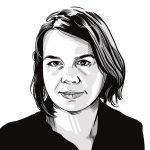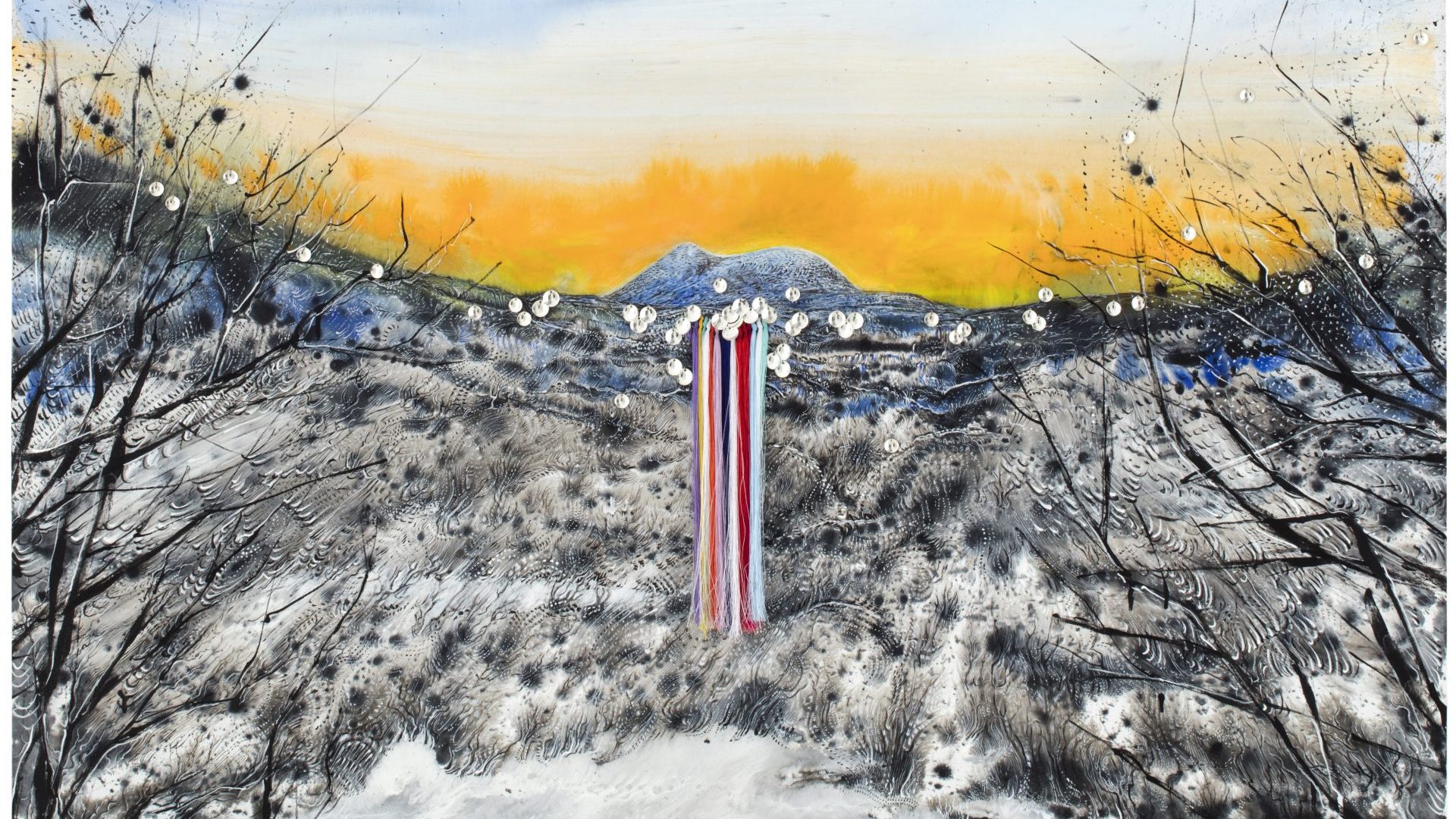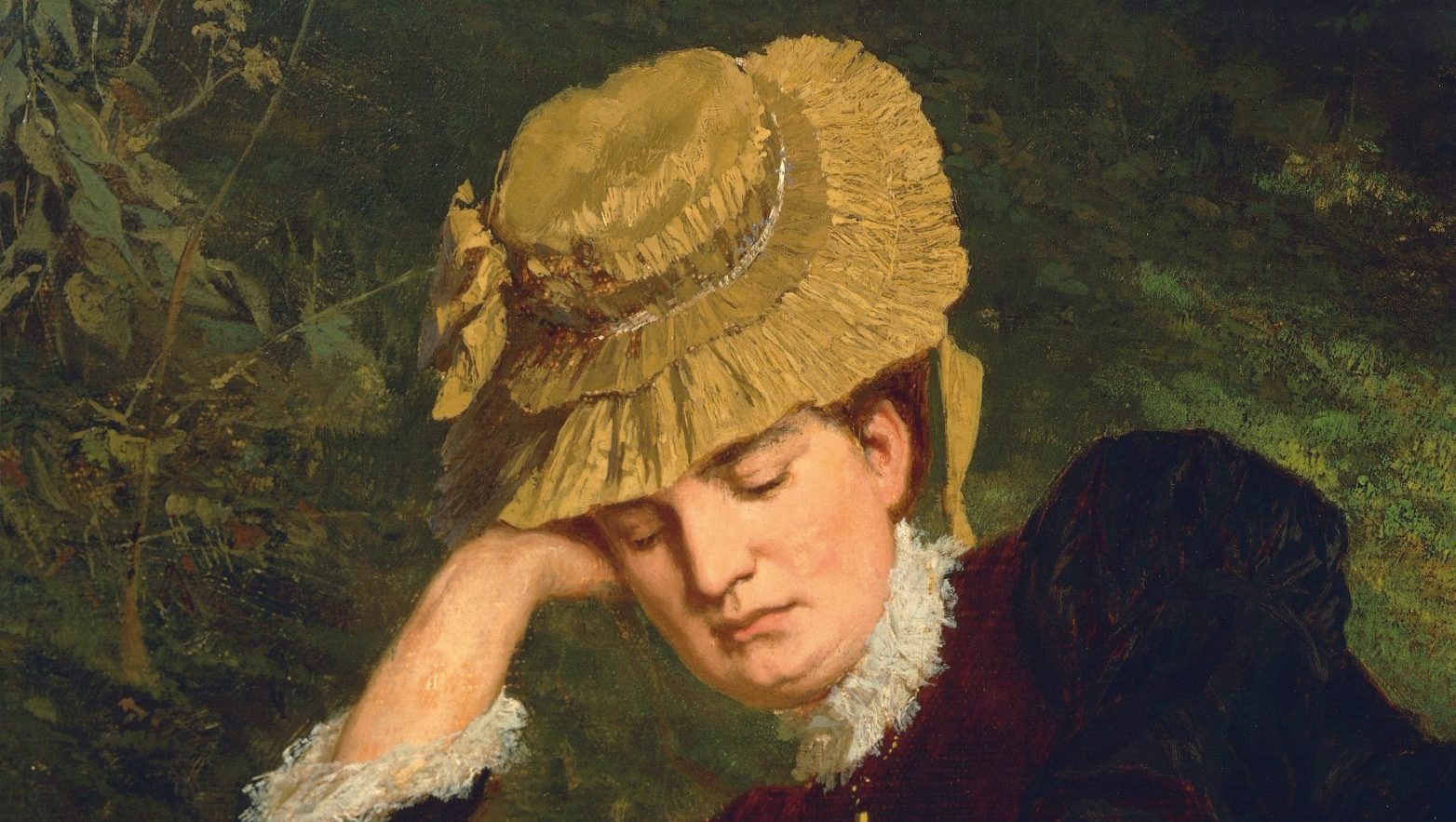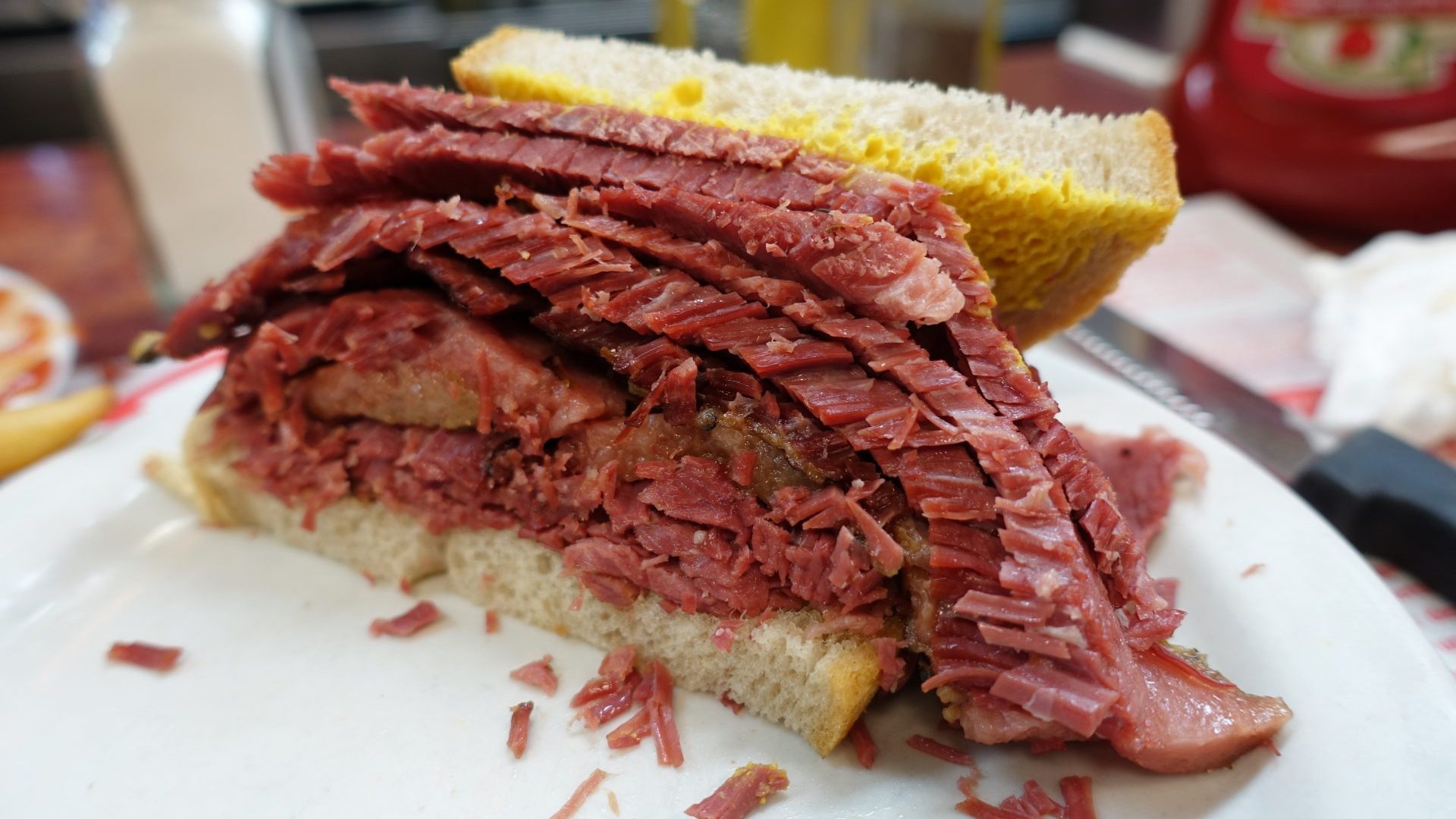In luminous colours, and kaleidoscopic variations of texture, Outi Pieski’s paintings and textile-based installations conjure visions of Sápmi, the Arctic home of the indigenous Sámi people, which today extends across the northern reaches of Finland, Norway, Sweden, and Russia’s Kola Peninsula.
With titles like Sacred Mountain as a Legal Person, Black Fell Giisavárri and Land of Gold, the works in Pieski’s first major UK show, at Tate St Ives until May 6, evoke the intimate bond with the land, so essential to the Sámi people’s traditional, semi-nomadic existence as reindeer herders.
Born in Helsinki in 1973, Pieski graduated from the Finnish Academy of Fine Arts in 2000. Now based in the Sámi village of Ohcejohka (Utsjoki), at Finland’s most northerly point, Pieski straddles two worlds, and is described by Sámi writer and artist Pauliina Feodoroff as “a harbinger of a new age: the first visual artist of her kind in a region that only became familiar with the word ‘art’ in the decade of her birth.”
Housed in some of the west’s most prestigious collections, including the National Museum Collection Norway, Moderna Museet in Stockholm, and Helsinki’s Museum of Contemporary Art Kiasma, in Sápmi her paintings hang in the offices of Sámi Radio, and a “three-dimensional painting” makes a vibrant addition to the new hospital in Rovaniemi.
Her appeal is international but, says Pieski, her work “always comes from the land and it’s made for the land”. At its core, it is an act of communion with nature, a conduit through which she can maintain an ongoing dialogue with the ancestral traditions of her homeland.
High up on cliffs buffeted by the Atlantic, Tate St Ives is a sympathetic location for Pieski’s UK debut. “There are clearly interesting ways of viewing this exhibition precisely because we’re based in an area that is surrounded by land, very close to nature,” says director Anne Barlow, pointing out that St Ives, which in the mid-20th century was home to some of the leading figures of the avant-garde, has the only artist residency in the whole of the Tate organisation.
Pieski arrived in Cornwall in January, and in a studio previously occupied by Patrick Heron and Ben Nicholson, got to work on Spell on Me!, a “three-dimensional painting” made from the brightly coloured tassels used on traditional Sámi shawls. She describes the invigorating effect of seeing the sun for the first time in months, having arrived during the dark months of the Arctic winter.
The predicament faced by the Sámi people is nothing short of existential, but there are nevertheless broad parallels to be drawn with the hardships experienced by the Cornish, whose support for Brexit can be at least partly attributed to the negative effects of overtourism, second homes, and climate change.
“We’ve found that over the years, audiences have been drawn to artists who have worked around ideas of extraction, mining, industrial abuse of the landscape. These are themes that are very, very relevant here and environmental activism is something that is quite prevalent in Cornwall,” says Barlow.
“I think people might respond to the show on many different levels, and some might bring ideas around the preservation of culture, the preservation of language. What we’re not saying is that there’s supposed to be a direct parallel. But it is interesting that it is in this region where those kinds of issues are important.”
The luminous surface of Close By the Aspens, 2009, is an uncanny simulacrum of lichen-encrusted bark, and typical of the way that Pieski combines minute observation with a mystical reverence for nature. Its elegiac quality avoids sentimentality, and is laced instead with the menace of existential threat that has loomed over the Sámi people, in one way or another, since the 17th century, when Sápmi’s exceptional mineral wealth was first discovered.
Today its 40 active mines include the world’s largest iron ore mine, its extractable resources have extended to oil and natural gas, and the land with its precious lichen so essential to the reindeer is newly vulnerable to windfarms, as well as the infrastructure that accompanies such projects.
The state-sanctioned dispossession of the Sámi people gained momentum in the 19th century, when aggressive policies of Scandinavisation were imposed by Sweden, Norway and Finland, banning Sámi languages, forcing conversion to Christianity, and confiscating items of cultural significance, such as costume. The second world war and its aftermath, the actions of the Soviet Union, and the Chernobyl disaster of 1986, have scarred Sápmi and its people still further.
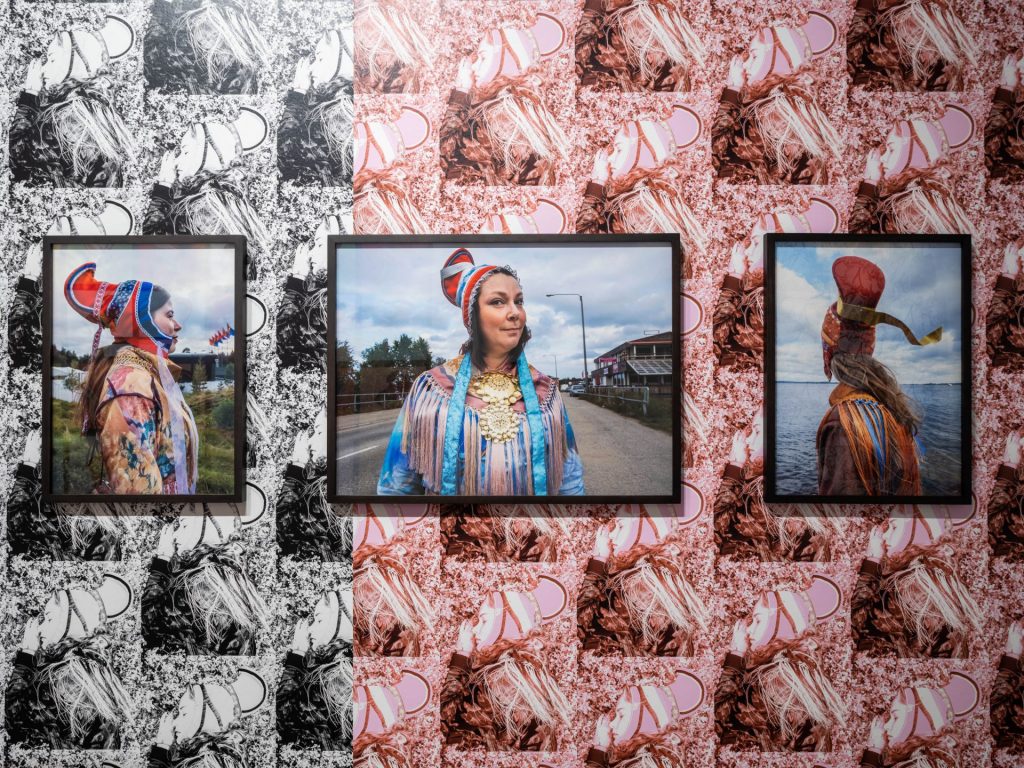
As recently as the 1960s, children were removed to boarding schools, where they were indoctrinated with the majority culture, and taught to feel ashamed of the indigenous way of life. In 1922, the Swedish State Institute for Racial Biology was established with the specific aim of “proving” the genetic inferiority of the Sámi, in order to justify a ban on interracial mixing with the Scandinavian population, a policy that inevitably caused their further stigmatisation, segregation and oppression.
Despite the founding of Sámi parliaments in each nation state since the 1980s, and an increased awareness of indigenous culture exemplified by the inaugural Sámi Pavilion at the 2022 Venice Biennale, colonialism is far from over. In a pair of paintings by Pieski entitled Pacing the Borders, the cumulative impact of the forced displacement of communities, the restrictions on grazing rights for reindeer, the culling of herds, the closing of borders, now and over centuries, is recorded on the landscape.
In a film made about the Sámi Pavilion in 2021, the writer and artist Máret Ánne Sara grappled with the scale of the trauma, asking: “What happens when your laws and systems force you to break with your own ethics and morals; and when colonial world views criminalise traditions and capitalise nature?”
The gulf between Sámi and colonial ways of thinking is encapsulated in the indigenous word čatnosat, which expresses the fundamental Sámi belief in the interdependence of all things, a quality so evident in Pieski’s work. Jan Erik Lundstrom, the former director of the Sámi Center for Contemporary Art, explains that for Pieski, “nature is not an Other, nature is not that which exists in opposition to the human world of culture… Likewise, landscape is not a noun, an object, a thing, but always a verb, an activity, an event.”
Taking only what is needed, and of returning what remains to the earth is a way of thinking largely irreconcilable with a capitalist mindset, and yet as climate catastrophe becomes ever harder to ignore, its unarguable wisdom becomes increasingly clear.
By incorporating reindeer bones in her paintings, along with other materials from daily life, Pieski makes her art a part of this living philosophy: “We have the responsibility to keep that connection”, she says. “Indigenous peoples are forced to be on the front line of the climate crisis, because the indigenous territories are the rare places where it’s still a healthy environment and a rich ecosystem. But it is so important to understand that these questions are for everybody.”
Her work also invokes the traditional Sámi practice of duodji, a term that roughly translates as “art, handicraft or homecraft”, but that Pieski explains has considerably more nuance: “It is a holistic concept that preserves the Sámi philosophy, values and spirituality and connects them with practical skills. In Sámi culture, material is seen not as passive but as an active author. Material items hold energy and power. The energy comes from the material itself, the maker who has transformed the material through skills, care and love, and the user who has used and lived with the item and its power.”
For her, “painting has always been a way to reconnect with my homeland”, and she describes it as a meditative, intuitive process. She mixes her own acrylic paints to a fluid, free-moving consistency, so that, “it’s a kind of collaboration between me and the paint. I try to make my paintings so that I’m not controlling it – it’s like a kind of ‘auto’ writing.”
Made from the coloured tassels found in traditional Sámi shawls, Pieski’s “three-dimensional painting” Beavvit – Rising Together II, 2021, is an example of duodji, its materials and the collaborative manner of its creation by a group of Sámi women tying Pieski and her contemporaries to their ancestors, while simultaneously looking forward to the generations to come.
The role of women in duodji relates to the concept of “rematriation”, the process of reconnecting with aspects of culture lost as a consequence of Scandinavian colonialism. It picks up where repatriation ends, and focuses on the recovery of women’s and other marginalised people’s histories, values and knowledge, with a view to achieving an equitable and integrated approach to culture and ecology.
The ládjogahpir, the horn-like headdress traditionally worn by Sámi women, is a powerful example of the rematriation of a cultural artefact, and symbol of female power, that was outlawed in the 19th century by Christian missionaries who regarded it as demonic. In a vibrant homage to Andy Warhol’s series of police mugshots, 13 Most Wanted Men, 1964, The 47 Most Wanted Foremothers, 2019, documents 47 of 60 ládjogahpirat currently held in European museums. For Pieski, and Finnish archaeologist Eeva-Kristiina Nylander with whom she collaborated on the project entitled Foremothers’ Hat of Pride, 2017-21, the return of these hats, as well as other items of Sámi cultural heritage, is vital to the decolonisation of Sápmi.
The notion of active colonialism in 21st century Europe is rightly shocking, and Sámi people experience quite differing degrees of justice and freedom according to which nation-state their region falls within, and in Russia, where the Sámi are not recognised, there is no official Sámi parliament.
Even within the three Scandinavian nations, the treatment of Sámi people is a troubling challenge to our perceptions of the Nordic countries as beacons of equality and social justice. In a publication that accompanied the Sámi Pavilion, entitled Čatnosat: Indigenous Art, Knowledge and Sovereignty, Sweden is described as having a “totalitarian attitude to Sámi relations, currently and in the past”, exemplified by its failure to ratify the UN’s Convention on Indigenous People (ILO 169) in the 1980s, despite having pressed for it.
Pieski’s fears for the future are bleakly straightforward: if the Sámi people lose their relationship with the land, their entire way of life will disappear. Somehow, she is able to envisage a happier outcome in an extraordinary series of paintings of the mountain Rástegáisá, that sparkle and vibrate with joy.
In Sacred Mountain Rástegáisá as a Legal Person I, 2018, Pieski pictures a jubilant landscape, which she imagines has been granted status as a “legal person”, in line with the 2008 constitution of Ecuador which took the unprecedented step of recognising the “rights of nature”. Pieski explains that the constitution “allows a threatened land site to be represented by a community that inhabited the area before a nation-state’s legislation.”
Independent Right to Exist and Flourish, 2018, takes one of the Ecuadorian provisions as a title, and Pieski explains “The mountain Rástegáisá has an inherent right to be Rástegáisá without being subjected to the extraction of resources, such as ‘green’ wind electricity or for tourism.”
For indigenous peoples at the sharp end of climate change, it’s an unarguable position. The question remains as to whether it will gain sufficient traction in the wider world, and how soon.
Outi Pieski is at Tate St Ives until May 6

